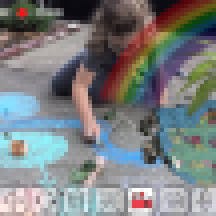Once upon a time, the classrooms had four walls, dusty chalkboards and uncomfortable desks in straight little rows. Students were silent, repeated what they were told and limited by their past experiences.
Thankfully, for many classrooms, those days of rigid learning are long gone. Our lessons can now include unimaginable experiences and interactions through immersive technology.
A compelling use for using immersive technology, like augmented and virtual reality, is learning through storytelling. Stories are a powerful way to deliver meaningful and relevant content. The learning is heightened when paired with a story that penetrates the heart of the student. Let’s explore some of the newest and best tools out there and see if we can’t get students to create their happily ever after.

Teachers can bring VR stories into the classroom in many different ways for meaningful learning experiences. Imagine a scavenger hunt where students narrate a story based on what they find. Or consider using objects they see to identify vocabulary words or recognize letters. Students should have purpose in their viewing and it should directly connect to standards.
Starting with virtual reality, stories in apps such as Google Spotlight Stories and YouTube 360 videos have been popular from the start. Similar to the new movie, Ready Player One, they provide an intense experience where the viewer feels like they are in the center of the story. Using a mobile device or tablet, the student can start the story and look around the scene based on their interest, rather than the cameras focus. New apps such as Baobab VR have continued to appear with more interactions and engagement. A headset isn’t required, and most of these experiences can also be viewed on a computer by clicking and dragging around on the screen.
____________________________________________________________________________
CREATION IDEA (ISTE Standard for Students: Knowledge Constructor)
Do you want your students to create stories using a 360° image? If you don’t have access to a 360 camera, capturing a 360 image is easy and free using the Google Street View app. A creative way to have your students create their own virtual stories is using the app Roundme. Upload your 360 image and add directional sound, links and content. Upload portals to walk the viewer into multiple scenes and then easily share the stories by link to the story. Forget the limited book reports to demonstrate knowledge, and embrace 3D expression.
____________________________________________________________________________
Newer augmented reality apps that work with ARKit have taken another approach to storytelling. Instead of the stories taking shape around you in an entirely digital experience, the story is placed in your space such as a desk in your classroom or the floor. As the stories are layered through the lens of the device, they provide a more seamless, realistic experience. Some of the new apps include Augmented Stories and My Hungry Caterpillar. The stories are told in 3D, and your students can walk around the desk looking at the scene from every angle. Students have a choice in how they view the story, and it’s delivered in their preferred format. Many augmented reality storytelling apps are in development stages, including Qurious, a company that is working on a release blending gaming, making and storytelling in one app.
If you don’t have access to a newer device that can power ARKit or ARCore, there are many other storytelling augmented reality apps to try. One app, called Storyfab, turns our students into the directors of the show. Instead of viewing an AR story that’s created by a developer, the students create their own own story. Using augmented reality, students add characters, props, emotions and actions to develop the plot of the story. The camera view can see the scene from any angle or position to capture the best part of the story while capturing the experience.
____________________________________________________________________________
CREATION IDEA (ISTE Standard for Students: Creative Communication)
In the sixth ISTE student standard, students are expected to become creative communicators. Since students are practically unlimited in their capacity for imagination, they can construct creative stories using AR in Storyfab and then share the video to peers or family members. Imagine the kinds of stories your students can create using their vocabulary words or historical figures. The AR stories can take the place of outdated classroom activities that rely heavily on memorization or following strict procedures.
____________________________________________________________________________

Another obvious way to use augmented reality in storytelling is through books (that is, print books with an AR layer). A new AR book, SpyQuest, has moved the immersive experience a big step forward as it helps define the story by bringing the images to life. Through the camera lens on a device, the stories make students the agents in an adventure into the world of espionage. The augmented reality experiences on the images use the accompanying app to scan the scene and provide further insight into the story.
Using immersive technology, our stories have never seemed so real. We can control where the stories come to life, how the scene is animated and even interact with the characters. Educators continue to look for innovative ways for students to learn and show their knowledge, especially considering our student standards. Don’t look back to the past of stories, but look ahead as more resources are released every day.


